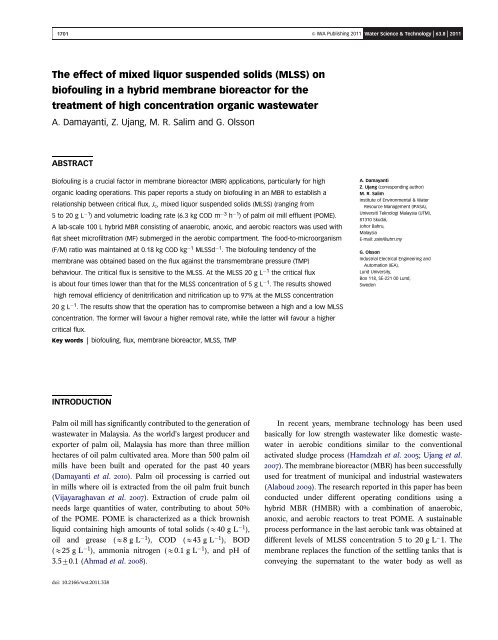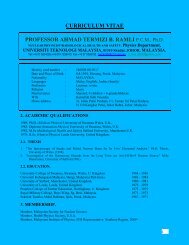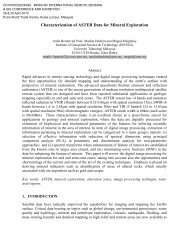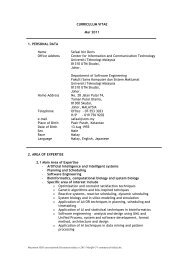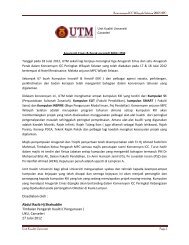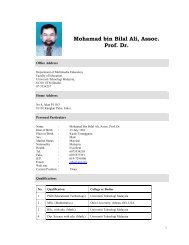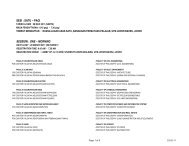The effect of mixed liquor suspended solids - Universiti Teknologi ...
The effect of mixed liquor suspended solids - Universiti Teknologi ...
The effect of mixed liquor suspended solids - Universiti Teknologi ...
Create successful ePaper yourself
Turn your PDF publications into a flip-book with our unique Google optimized e-Paper software.
1701 & IWA Publishing 2011 Water Science & Technology 9 63.8 9 2011<br />
<strong>The</strong> <strong>effect</strong> <strong>of</strong> <strong>mixed</strong> <strong>liquor</strong> <strong>suspended</strong> <strong>solids</strong> (MLSS) on<br />
bi<strong>of</strong>ouling in a hybrid membrane bioreactor for the<br />
treatment <strong>of</strong> high concentration organic wastewater<br />
A. Damayanti, Z. Ujang, M. R. Salim and G. Olsson<br />
ABSTRACT<br />
Bi<strong>of</strong>ouling is a crucial factor in membrane bioreactor (MBR) applications, particularly for high<br />
organic loading operations. This paper reports a study on bi<strong>of</strong>ouling in an MBR to establish a<br />
relationship between critical flux, Jc, <strong>mixed</strong> <strong>liquor</strong> <strong>suspended</strong> <strong>solids</strong> (MLSS) (ranging from<br />
5to20gL1 ) and volumetric loading rate (6.3 kg COD m 3 h 1 ) <strong>of</strong> palm oil mill effluent (POME).<br />
A lab-scale 100 L hybrid MBR consisting <strong>of</strong> anaerobic, anoxic, and aerobic reactors was used with<br />
flat sheet micr<strong>of</strong>iltration (MF) submerged in the aerobic compartment. <strong>The</strong> food-to-microorganism<br />
(F/M) ratio was maintained at 0.18 kg COD kg 1 MLSSd 1 . <strong>The</strong> bi<strong>of</strong>ouling tendency <strong>of</strong> the<br />
membrane was obtained based on the flux against the transmembrane pressure (TMP)<br />
behaviour. <strong>The</strong> critical flux is sensitive to the MLSS. At the MLSS 20 g L 1 the critical flux<br />
is about four times lower than that for the MLSS concentration <strong>of</strong> 5 g L 1 . <strong>The</strong> results showed<br />
high removal efficiency <strong>of</strong> denitrification and nitrification up to 97% at the MLSS concentration<br />
20 g L 1 . <strong>The</strong> results show that the operation has to compromise between a high and a low MLSS<br />
concentration. <strong>The</strong> former will favour a higher removal rate, while the latter will favour a higher<br />
critical flux.<br />
Key words 9 bi<strong>of</strong>ouling, flux, membrane bioreactor, MLSS, TMP<br />
INTRODUCTION<br />
Palm oil mill has significantly contributed to the generation <strong>of</strong><br />
wastewater in Malaysia. As the world’s largest producer and<br />
exporter <strong>of</strong> palm oil, Malaysia has more than three million<br />
hectares <strong>of</strong> oil palm cultivated area. More than 500 palm oil<br />
mills have been built and operated for the past 40 years<br />
(Damayanti et al. 2010). Palm oil processing is carried out<br />
in mills where oil is extracted from the oil palm fruit bunch<br />
(Vijayaraghavan et al. 2007). Extraction <strong>of</strong> crude palm oil<br />
needs large quantities <strong>of</strong> water, contributing to about 50%<br />
<strong>of</strong> the POME. POME is characterized as a thick brownish<br />
liquid containing high amounts <strong>of</strong> total <strong>solids</strong> (E40 g L 1 ),<br />
oil and grease (E8 gL 1 ), COD (E43 g L 1 ), BOD<br />
(E25 g L 1 ), ammonia nitrogen (E0.1 g L 1 ), and pH <strong>of</strong><br />
3.570.1 (Ahmad et al. 2008).<br />
doi: 10.2166/wst.2011.338<br />
A. Damayanti<br />
Z. Ujang (corresponding author)<br />
M. R. Salim<br />
Institute <strong>of</strong> Environmental & Water<br />
Resource Management (IPASA),<br />
<strong>Universiti</strong> <strong>Teknologi</strong> Malaysia (UTM),<br />
81310 Skudai,<br />
Johor Bahru,<br />
Malaysia<br />
E-mail: zaini@utm.my<br />
G. Olsson<br />
Industrial Electrical Engineering and<br />
Automation (IEA),<br />
Lund University,<br />
Box 118, SE-221 00 Lund,<br />
Sweden<br />
In recent years, membrane technology has been used<br />
basically for low strength wastewater like domestic wastewater<br />
in aerobic conditions similar to the conventional<br />
activated sludge process (Hamdzah et al. 2005; Ujang et al.<br />
2007). <strong>The</strong> membrane bioreactor (MBR) has been successfully<br />
used for treatment <strong>of</strong> municipal and industrial wastewaters<br />
(Alaboud 2009). <strong>The</strong> research reported in this paper has been<br />
conducted under different operating conditions using a<br />
hybrid MBR (HMBR) with a combination <strong>of</strong> anaerobic,<br />
anoxic, and aerobic reactors to treat POME. A sustainable<br />
process performance in the last aerobic tank was obtained at<br />
different levels <strong>of</strong> MLSS concentration 5 to 20 g L 1. <strong>The</strong><br />
membrane replaces the function <strong>of</strong> the settling tanks that is<br />
conveying the supernatant to the water body as well as
1702 A. Damayanti et al. 9 <strong>The</strong> <strong>effect</strong> <strong>of</strong> <strong>mixed</strong> <strong>liquor</strong> <strong>suspended</strong> <strong>solids</strong> (MLSS) on bi<strong>of</strong>ouling in a hybrid membrane bioreactor<br />
Water Science & Technology 9 63.8 9 2011<br />
returning the <strong>solids</strong> back to the reactor (Qin et al. 2007).<br />
Internal bi<strong>of</strong>ouling due to the adsorption <strong>of</strong> dissolved matter<br />
into the membrane pores and pore blocking is considered<br />
irreversible and is generally only removed by chemical cleaning.<br />
<strong>The</strong>re are principally three strategies for limiting bi<strong>of</strong>ouling<br />
in submerged MBR process systems: maintaining the<br />
permeate flux below the critical flux, Jc, increasing the membrane<br />
aeration, and employing physical or chemical cleaning<br />
(Razak et al. 2007). Under constant-TMP or constant-flux<br />
conditions, the fouling mechanism will increase hydraulic<br />
resistance and the trans membrane pressure will be increased<br />
as permeate flux will be declined, as further studied by Qin<br />
et al. (2007).<br />
Many studies about bi<strong>of</strong>ouling at MBR in different MLSS,<br />
for several example Chang & Kim (2005) using synthetic<br />
wastewater, showed which cake resistance (Rc) decreased<br />
as MLSS concentration (between 0.09–3.7 g L 1 ) decreasing.<br />
Another study compared attached growth (MLSS between<br />
0.1–2 g L 1 ) and <strong>suspended</strong> growth (MLSS 3 g L 1 )microorganisms<br />
in MBR using municipal wastewater showed the<br />
rate <strong>of</strong> attached growth system 7 times higher affected the<br />
bi<strong>of</strong>ouling rate compare with <strong>suspended</strong> growth (Lee et al.<br />
2001). <strong>The</strong>refore this study was carried out to investigate<br />
performance and bi<strong>of</strong>ouling tendency at four different<br />
MLSS concentrations between 5 to 20 g L 1 in a hybrid<br />
MBR treating high strength wastewater, like POME. Thus<br />
the study has two aims: (1) to observe the bi<strong>of</strong>ouling through<br />
the critical flux, J c, which was determined using the flux step<br />
method and (2) to investigate the performance <strong>of</strong> the organic<br />
and nitrogen removal in the system at different MLSS levels.<br />
MATERIALS AND METHODS<br />
POME samples and pretreatment process<br />
<strong>The</strong> characteristics <strong>of</strong> raw POME collected from Felda Bukit<br />
Besar Palm Mill, Johor, Malaysia are shown in Table 1. Upon<br />
sampling the temperature <strong>of</strong> POME was measured at<br />
approximately 801C751C. POME samples used in this<br />
study were stored at 41C. <strong>The</strong> operating temperature was<br />
251C (room temperature in a tropical country). <strong>The</strong> POME<br />
was <strong>mixed</strong> in the reactor using a stirrer according to H<strong>of</strong>vendahl<br />
et al. (1999) for anaerobic compartment and Ramalho<br />
et al. (2004) for anoxic compartment, for agitation speed<br />
120 rpm or Newton number 4 to maximize the process.<br />
Finally the POME was collected in the feed tank to study<br />
the performance <strong>of</strong> different levels <strong>of</strong> MLSS. <strong>The</strong> F/M was<br />
calculated using Equation (1) based on measurements taken<br />
Table 1 9 Characteristics <strong>of</strong> POME compared to municipal sewage<br />
Symbol POME Values a Sewage b,c<br />
pH 5.6 7<br />
Tot COD 45 0.60<br />
TS (Total Solid) 43 0.80<br />
TDS (Total Dissolved Solid) 35 0.23<br />
SS (Suspended Solid) 8.2 0.56<br />
NVSS (Non Volatile<br />
Suspended Solid)<br />
from the experiment. <strong>The</strong> values <strong>of</strong> F/M range from 0.7 to<br />
1kgBOD5 kg MLSS 1 day 1 (Metcalf and Eddy 2004).<br />
F QS0<br />
¼<br />
M VX<br />
where F/M ¼ food to microorganism ratio<br />
S0 ¼ influent concentration (ML 3 )<br />
Q ¼ flowrate (L3T 1 )<br />
V ¼ volume (L3 )<br />
X ¼ biomass concentration (ML 3 ).<br />
Laboratory scale trials<br />
4.0 0.25<br />
NO3 0.10 0.01<br />
NO2 0.30 0.06<br />
NH 4 þ<br />
0.20 0.03<br />
Total Nitrogen 0.50 0.01<br />
*Note:<br />
a This study,<br />
b Nor-Anuar et al. (2007),<br />
cUjang et al. (2008)<br />
All parameter’s units in gL 1 except pH.<br />
<strong>The</strong> schematic process flow diagram for the lab scale HMBR<br />
is shown in Figure 1. A specification <strong>of</strong> the HMBR system is<br />
given in Table 2. For acclimatization the HMBR system was<br />
seeded with biological sludge taken from the wastewater<br />
treatment plant <strong>of</strong> the Felda Bukit Besar Palm Mill, Johor<br />
Bahru. <strong>The</strong> experiments were carried out at room temperature<br />
251C. <strong>The</strong> system was operated continuously (24-h)<br />
during this study, with acclimatization taking placed within<br />
two months and a total study duration <strong>of</strong> six months. Trials<br />
for different MLSS levels were conducted to obtain bi<strong>of</strong>ouling<br />
conditions. <strong>The</strong> HRT <strong>of</strong> the anaerobic, anoxic, and aerobic<br />
reactors, as shown in Table 2, were 11, 7, and 8 hours<br />
respectively. <strong>The</strong> flat sheet membrane (15cm 10cm) used<br />
ð1Þ
1703 A. Damayanti et al. 9 <strong>The</strong> <strong>effect</strong> <strong>of</strong> <strong>mixed</strong> <strong>liquor</strong> <strong>suspended</strong> <strong>solids</strong> (MLSS) on bi<strong>of</strong>ouling in a hybrid membrane bioreactor<br />
Water Science & Technology 9 63.8 9 2011<br />
Figure 1 9 Schematic process flow diagram.<br />
in this study had been kindly donated by Kubota, Inc. and was<br />
vertically submerged in the bioreactor. <strong>The</strong> size <strong>of</strong> the membrane<br />
bioreactor is 24cm 10cm 90cm. <strong>The</strong> height between<br />
the membrane module and the base <strong>of</strong> the reactor is 30 cm.<br />
<strong>The</strong> TMP was measured using an online system by installing a<br />
pressure transducer. For the aeration, the compressed air<br />
supplied individually and the flowrate has been used is 12<br />
LMH. Recirculation flow rate in this study was 1:3.<br />
<strong>The</strong> system is operated for acclimatization to the new<br />
media was about one a half months before starting experiments.<br />
<strong>The</strong> sludge divided into 4, for MLSS study 5, 10, 15<br />
and 20 g L 1 . After that, the sludge placed in cool room.<br />
<strong>The</strong>n the system operated using lowest MLSS first, 5 g L 1 ,<br />
acclimatized again around one to two weeks until steady state<br />
phase, and finished it in one month. After that, the sludge was<br />
replaced from reactor, using new sludge (from cool room)<br />
which have acclimatized before, but it is still need acclimatized<br />
again around one to two weeks until steady state phase,<br />
using MLSS 10 g L 1 , until finished in one month. <strong>The</strong> same<br />
step as MLSS 15 and 20 g L 1 . We excess sludge withdrawal<br />
and stationary MLSS for same SRT, 70 days. All step study<br />
finished in four months excluded acclimatization in two<br />
Table 2 9 <strong>The</strong> Specifications <strong>of</strong> the HMBR system<br />
Item Specifications<br />
Membrane type Flat sheet<br />
Membrane material Chlorinated Polyethylene<br />
Membrane pore size 0.4 mm<br />
Membrane area per module 0.1 m 2<br />
Number <strong>of</strong> modules 3<br />
Effective volume <strong>of</strong> anaerobic reactor 50 L<br />
Effective volume <strong>of</strong> anoxic tank 30 L<br />
Effective volume <strong>of</strong> aeration tank 20 L<br />
months. Flux 11 Lm 2 h 1 applied for operating condition<br />
in HMBR.<br />
During the studies, the fouled membranes were removed<br />
from the aeration reactor and cleaned with a sponge followed<br />
by water flush cleaning. <strong>The</strong> membranes were then soaked in<br />
a 0.5% ppm NaOCl and left overnight (Ujang et al. 2005).<br />
After this, the cleaned membranes were ready to be used<br />
again in the process (Ujang et al. 2005).<br />
Critical flux evaluation<br />
<strong>The</strong> flux step method is used to determine the critical flux<br />
(Le-Clech et al. 2003). <strong>The</strong> critical flux measured at the start<br />
for each period. This carried out by increasing values <strong>of</strong><br />
permeate flux and recording the relative TMP variations.<br />
For each flux step two TMP values were considered: the<br />
initial TMP, corresponding to the initial sudden increase <strong>of</strong><br />
the filtration resistance, and the final TMP, i.e. the TMP at the<br />
end <strong>of</strong> the step (Le-Clech et al. 2003). From these two TMP<br />
values two parameters connected to fouling can be evaluated,<br />
the average TMP and the rate <strong>of</strong> change <strong>of</strong> the TMP (dTMP/<br />
dt). Any flux with dTMP/dtZ0.5 is defined as the critical flux<br />
(Bottino et al. 2009). By using resistance series model as in<br />
Equation (2), Rtot or total filtration resistance then could be<br />
calculated (Chang & Kim 2005):<br />
Rtot ¼ Rm þ Rc þ R f<br />
where Rtot is the total filtration resistance, Rm is the intrinsic<br />
membrane resistance (obtained from pure water permeability<br />
measurements), Rc is the cake resistance, and Rf is the fouling<br />
resistance due to irreversible adsorption and pore plugging<br />
(Bottino et al. 2009). Rm and Rtot were calculated according to<br />
Darcy’s law below:<br />
R ¼ TMPm 1 J 1<br />
ð2Þ<br />
ð3Þ
1704 A. Damayanti et al. 9 <strong>The</strong> <strong>effect</strong> <strong>of</strong> <strong>mixed</strong> <strong>liquor</strong> <strong>suspended</strong> <strong>solids</strong> (MLSS) on bi<strong>of</strong>ouling in a hybrid membrane bioreactor<br />
Water Science & Technology 9 63.8 9 2011<br />
J (Lm –2 h –1 )<br />
45<br />
40<br />
35<br />
30<br />
25<br />
20<br />
15<br />
10<br />
5<br />
0<br />
where m is the fluid viscosity and J is the flux. Permeate flux (J)<br />
applied from 0 to 40 Lm 2 h 1 for critical flux test, 15 minute<br />
for one value constant. <strong>The</strong> critical flux measured at the start<br />
each test period pf MLSS. Each MLSS concentration used<br />
new membrane.<br />
Samples analysis<br />
Laboratory experiments were carried out in the Environmental<br />
Engineering Laboratory, UTM. All experimental analysis<br />
was conducted according to Standard Methods (APHA 1998)<br />
within three hours after sampling. MLSS concentrations were<br />
regularly measured. Chemical Oxygen Demand, NO 3-N,<br />
NO2-N, NH4-N, and PO4-P were analysed using a spectrophotometer<br />
(HACH/DR 4000). <strong>The</strong> measurements were<br />
carried out in duplicate according to HACH testing procedures.<br />
<strong>The</strong> average values were taken for different MLSS<br />
concentrations between 5 and 20 g L 1 .Dissolvedoxygen<br />
concentration, temperature and pH were monitored using an<br />
on-line measurement system, and the biotransformation was<br />
observed using on-line respirometry. <strong>The</strong> DO probe used in<br />
this work was the WTW Oxil oxygen meter. It was calibrated<br />
with pure water before being used in the membrane bioreactor.<br />
RESULTS AND DISCUSSION<br />
MLSS 5 gL –1<br />
MLSS 10 gL –1<br />
MLSS 15 gL –1<br />
MLSS 20 gL –1<br />
0 100 200 300 400 500<br />
TMP (mbar)<br />
Figure 2 9 TMP and J behavior during ascending and descending runs at different MLSS<br />
concentrations with Y error bar 5%.<br />
Behaviour <strong>of</strong> membrane critical flux in MBR operation<br />
Figures 2 and 3, andTable 3 show the influence <strong>of</strong> different<br />
MLSS concentrations on the TMP and bi<strong>of</strong>ouling behaviour.<br />
dTMP/dt (mbar/sec)<br />
18<br />
16<br />
14<br />
12<br />
10<br />
8<br />
6<br />
4<br />
2<br />
0<br />
0 5 10 15 20 25<br />
Jc (Lm –2h –1 MLSS 5 gL<br />
)<br />
–1<br />
MLSS 10 gL –1<br />
MLSS 15 gL –1<br />
MLSS 20 gL –1<br />
Figure 3 9 Trend <strong>of</strong> dTMP/dt (mbar/sec) as a function <strong>of</strong> the flux at MLSS concentrations 5–<br />
20 gL 1 with Y-error bar 5%.<br />
<strong>The</strong> values in Table 3 are calculated using Equation (3). <strong>The</strong><br />
results clearly demonstrate that the membrane bi<strong>of</strong>ouling rate<br />
increases with an increase in the MLSS concentration. <strong>The</strong><br />
results obtained indicate that the MLSS concentration has a<br />
significant influence on the trans membrane pressure (TMP).<br />
Figure 2 shows the flux vs. TMP behaviour, during the<br />
ascending and descending run <strong>of</strong> membrane with POME at<br />
different MLSS concentrations. <strong>The</strong> differences between two<br />
runs were significant.<br />
During the ascending run, the flux first proportionally<br />
increased with an increase in the TMP and leveled <strong>of</strong>f, more<br />
quickly at higher MLSS concentrations, due to membrane<br />
bi<strong>of</strong>ouling. <strong>The</strong> detrimental <strong>effect</strong> <strong>of</strong> fouling on the membrane<br />
flux is also apparent by observing the behaviour <strong>of</strong> the<br />
membrane flux as a function <strong>of</strong> the applied TMP during the<br />
descending run.<br />
Figure 3 shows the trend <strong>of</strong> dTMP/dt as a function <strong>of</strong> the<br />
flux determined from the ascen-ding runs <strong>of</strong> various hysteresis<br />
loops <strong>of</strong> Figure 2. From the reported trend the critical<br />
flux, i.e. the flux corresponding to dTMP/dt ¼ 0.5 can<br />
be easily calculated. <strong>The</strong> critical flux values are reported in<br />
Table 3, along with the values <strong>of</strong> various resistances. Figure 3<br />
also shows that by increasing the MLSS concentration from 5<br />
to 20 g L 1 the critical flux becomes four times lower.<br />
Although the Rm value <strong>of</strong> the membrane was very low,<br />
Table 3 9 Effect <strong>of</strong> MLSS concentration on critical flux and resistances <strong>of</strong> POME<br />
No MLSS (g/L) Jc (Lm 2 h 1 ) Rtot (10 12 m 1 ) Rm (10 12 m 1 ) Rc þ Rf (10 12 m 1 )<br />
1 5 9.2 1.73 0.19 1.54<br />
2 10 7.1 2.04 0.19 1.85<br />
3 15 4.7 2.83 0.19 2.64<br />
4 20 2.5 3.90 0.19 3.71
cake formation and fouling occurred during the treatment<br />
process. Table 3 demonstrates that higher MLSS will lead to<br />
higher R tot. <strong>The</strong>R m value led to a significant increase <strong>of</strong> the<br />
total resistance, since bi<strong>of</strong>ouling and cake formation take<br />
place, especially at high MLSS concentration (Bottino et al.<br />
2009). Unlike Bottino et al. (2009), Chang & Kim (2005)<br />
showed that the Rm value not always led to a significant<br />
increase <strong>of</strong> the total resistance, especially at low MLSS<br />
concentration. This is in line also with Chang & Kim (2005)<br />
that found that R c, cake resistance, will decrease as MLSS<br />
between 3.7 to 0.09 g L 1 decrease.<br />
Chang & Kim (2005) also showed that higher MLSS<br />
concentrations lead to higher higher Rtot. <strong>The</strong> rate <strong>of</strong> TMP<br />
increase was found to generally increase with increasing<br />
MLSS concentration at each flux tested because <strong>of</strong> higher<br />
<strong>suspended</strong> <strong>solids</strong> in the reactor (Bottino et al. 2009). Furthermore,<br />
at each MLSS concentration, dTMP/dt increased with<br />
increasing flux-step. In addition, Rosenberger & Kraume<br />
(2002) who found that higher SS concentration affected<br />
lower F/M ratio and also lower EPS concentration, led to<br />
better filterability.<br />
COD, NO 3 ,NO 2 ,andNH 4 þ removal efficiency at<br />
different flux and MLSS<br />
COD, NO3 ,NO2 ,andNH4 þ removal efficiencies at different<br />
MLSS are shown in Figure 4. Towards the end <strong>of</strong> the<br />
experimental period the feed COD concentration had an<br />
average <strong>of</strong> 40.5 g L 1 , while the effluent concentration was<br />
kept in the range 200 to 350 mg L 1 depending on the POME<br />
source quality and MLSS used in the MBR. <strong>The</strong>se mean<br />
values here is continuous with acclimatized sludge from lab<br />
scale hybrid MBR. This effluent quality need to be treated<br />
further to meet effluent quality standard (Environmental<br />
Quality Regulation 2009).<br />
Figure 4 also demonstrates a COD removal efficiency <strong>of</strong><br />
up to 99%. <strong>The</strong> NO 3-N effluent concentration depends on the<br />
Removal efficiency (%)<br />
1705 A. Damayanti et al. 9 <strong>The</strong> <strong>effect</strong> <strong>of</strong> <strong>mixed</strong> <strong>liquor</strong> <strong>suspended</strong> <strong>solids</strong> (MLSS) on bi<strong>of</strong>ouling in a hybrid membrane bioreactor<br />
Water Science & Technology 9 63.8 9 2011<br />
100<br />
99.5<br />
99<br />
98.5<br />
98<br />
97.5<br />
97<br />
96.5<br />
5 10 15 20<br />
MLSS (gL –1 )<br />
COD<br />
NO 3 –<br />
NO 2 –<br />
NH 4 +<br />
Figure 4 9 COD, NO3 ,NO2 ,andNH4 þ removal efficiency at different MLSS concentrations <strong>of</strong><br />
the POME with Y error bar 0.2%, respectively.<br />
POME source quality and the average removal rate is up to<br />
97%. This is comparable with other studies, where NO3<br />
removal using aerobic treatment was up to 95% (Kumbasar<br />
2009) and 95% NH4 þ removal (Sarioglu et al. 2009). In Figure<br />
4 it is shown that the rate <strong>of</strong> removal efficiency generally<br />
increases with increasing MLSS concentration at each flux<br />
tested because <strong>of</strong> higher biomass activity working in the<br />
reactor (Alaboud 2009) Furthermore, at each MLSS concentration,<br />
dTMP/dt increased with increasing flux-step. This is<br />
why balancing the bi<strong>of</strong>ouling tendency and effluent quality is<br />
needed to reduce operation and maintenance costs in a<br />
wastewater treatment plant (Ujang et al. 2008). It is not a<br />
big difference but it is important for the effluent quality at<br />
high MLSS concentrations. However it is also important to<br />
consider the bi<strong>of</strong>ouling <strong>effect</strong> at high MLSS concentrations.<br />
CONCLUSIONS<br />
This study has indicated that the membrane bi<strong>of</strong>ouling rate<br />
increases with an increasing MLSS concentration, as<br />
observed through the critical flux analysis and extensive<br />
experimental results for POME. During the experiments <strong>of</strong><br />
increasing MLSS the flux first increased proportionally with<br />
the increase in TMP and levelled <strong>of</strong>f, more quickly at higher<br />
MLSS concentration, due to membrane bi<strong>of</strong>ouling. <strong>The</strong> detrimental<br />
<strong>effect</strong> <strong>of</strong> fouling on the membrane flux is also apparent<br />
by observing the behaviour <strong>of</strong> the membrane flux as a function<br />
<strong>of</strong> the applied TMP during the descending run. <strong>The</strong> rate<br />
<strong>of</strong> change in the TMP was found to generally increase with<br />
increasing MLSS concentration at each flux tested. <strong>The</strong> study<br />
also showed that the removal increased with increasing<br />
MLSS concentrations. In general, the results from this<br />
paper indicate the need to balance the bi<strong>of</strong>ouling tendency<br />
and the effluent quality to reduce operation and maintenance<br />
costs in wastewater treatment plants, for high strength wastewater<br />
such as POME.<br />
ACKNOWLEDGEMENTS<br />
This study was made possible by the financial support from<br />
the Ministry <strong>of</strong> Science <strong>of</strong> Technology (MOSTI) Malaysia<br />
through eScience funding (Vot 79006) and Islamic Development<br />
Bank for providing scholarship. Thanks to Mr. Zulkifli<br />
Ahmad for special assistance and discussions, and thanks to<br />
Institute Technology <strong>of</strong> Sepuluh Nopember for supporting the<br />
first author. Membrane modules were kindly donated by<br />
Kubota Inc.
1706 A. Damayanti et al. 9 <strong>The</strong> <strong>effect</strong> <strong>of</strong> <strong>mixed</strong> <strong>liquor</strong> <strong>suspended</strong> <strong>solids</strong> (MLSS) on bi<strong>of</strong>ouling in a hybrid membrane bioreactor<br />
Water Science & Technology 9 63.8 9 2011<br />
REFERENCES<br />
Ahmad, Z., Ujang, Z., Yunus, S., Damayanti, A. & Olsson, G. 2008 A<br />
Novel Approach for Palm Oil Mill Effluent (POME) Treatment<br />
And Recovery Using Hybrid Membrane Bioreactor. Asia Water<br />
Conference. Kuala Lumpur.<br />
Alaboud, S. T. M. 2009 Membrane Bioreactor for Wastewater Reclamation-Pilot<br />
Plant Study in Jeddah, Saudi Arabia. J. <strong>of</strong> Env. Sci. 3,<br />
267–277.<br />
APHA 1998 Standard Methods for the Examination <strong>of</strong> Water and<br />
Wastewater, American Public Health Association: Washington<br />
DC, USA.<br />
Bottino, A., Capannelli, G., Comite, A. & Mangano, R. 2009 Critical flux<br />
in submerged membrane bioreactors for municipal wastewater<br />
treatment. Desalination 245(1–3), 748–753.<br />
Chang, I. S. & Kim, S. N. 2005 Wastewater treatment using membrane<br />
filtration—<strong>effect</strong> <strong>of</strong> bio<strong>solids</strong> concentration on cake resistance.<br />
Proc. Biochem. 40, 1307–1314.<br />
Damayanti, A., Ujang, Z., Salim, M. R., Olsson, G. & Sulaiman, A. Z.<br />
2010 Respirometric analysis <strong>of</strong> activated sludge models from palm<br />
oil mill effluent. Biores. Technol. 101(1), 144–149.<br />
Environmental Quality (Industrial Effluent) Regulation 2009 Malaysia.<br />
Hamdzah, M., Ujang, Z. & Ozaki, H. 2005 Reverse Osmosis (RO) for<br />
Micropollutant Rejection: <strong>The</strong> Effect <strong>of</strong> Low Pressure System.<br />
Water Malaysia No: 10 (August 2005).<br />
H<strong>of</strong>vendahl, K., van Niel, W. J. & Hahn-HaÈ gerdal, B. 1999 Effect <strong>of</strong><br />
temperature and pH on growth and product formation <strong>of</strong> Lactococcus<br />
lactis ssp. lactis ATCC 19435 growing on maltose. J. Appl<br />
Microbiol Biotechnol. 51, 669–672.<br />
Kumbasar, R. A. 2009 Separation and concentration <strong>of</strong> cobalt from zinc<br />
plant acidic thiocyanate leach solutions containing cobalt and<br />
nickel by an emulsion liquid membrane using triisooctylamine as<br />
carrier. J. Mem. Sci. 333(1–2), 118–124.<br />
Le-Clech, P., Jefferson, B., Chang, I. S. & Judd, S. J. 2003 Critical flux<br />
determination by flux-step method in a submerged membrane<br />
bioreactor. Journal Membrane Science 227(1–2), 81–93.<br />
Lee, J., Ahn, W. Y. & Lee, C. H. 2001 Comparison <strong>of</strong> the filtration<br />
characteristics between attached and <strong>suspended</strong> growth microorganisms<br />
in submerged membrane bioreactor. Wat. Res. 35(10),<br />
2435–2445.<br />
Metcalf. and Eddy 2004 Wastewater Engineering: Treatment and Reuse.<br />
Singapore, McGraw-Hill.<br />
Nor-Anuar, A., Ujang, Z., van Loosdrecht, M. C. M. & de Kreuk, M. K.<br />
2007 Settling behaviour <strong>of</strong> aerobic granular sludge. Wat. Sci. Tech.<br />
56(7), 55–63.<br />
Qin, J. J., Oo, M. H., Tao, G. & Kekre, K. A. 2007 Feasibility study on<br />
petrochemical wastewater treatment and reuse using submerged<br />
MBR. J. Mem. Sci. 293(1–2), 161–166.<br />
Ramalho, P. A., Cardoso, M. H., Paulo, A. C. & Ramalho, T. 2004<br />
Characterization <strong>of</strong> Azo Reduction Activity in a Novel Ascomycete<br />
Yeast Strain. J. Appl. Env. Microbiology 70(4), 2279–2288.<br />
Razak, A. R. A., Ujang, Z. & Ozaki, H. 2007 Removal <strong>of</strong> endocrine<br />
disrupting chemicals (EDCs) using low pressure reverse osmosis<br />
membrane. Wat. Sci. Tech. 56(8), 161–168.<br />
Rosenberger, S. M. & Kraume 2002 Filterability <strong>of</strong> activated sludge in<br />
membrane bio-reactors. Desalination 146, 373–379.<br />
Sarioglu, M., Insel, G., Artan, N. & Orhon, D. 2009 Model evaluation <strong>of</strong><br />
simultaneous nitrification and denitrification in a membrane<br />
bioreactor operated without an anoxic reactor. J. Mem. Sci.<br />
337(1–2), 17–27.<br />
Ujang, Z., Ng, K. S., Hamzah, T. H. T., Roger, P., Ismail, M. R.,<br />
Shahabudin, S. M. & Abdul Hamid, M. H. 2007 Application <strong>of</strong><br />
immersed MF (IMF) followed by reverse osmosis membrane for<br />
wastewater reclamation: <strong>The</strong> case <strong>of</strong> Malaysia. Wat. Sci. Tech.<br />
56(9), 103–108.<br />
Ujang, Z., Ng, S. S. & Nagaoka, H. 2005 Package plant <strong>of</strong> extended<br />
aeration membrane reactors: A study on aeration intensity and<br />
bi<strong>of</strong>ouling control. Wat. Sci. Tech. 51(10), 335–342.<br />
Ujang, Z., Talib, J. & Sairan, F. M. 2008 Rationalization <strong>of</strong> Small-sizes<br />
Wastewater Treatment Plant: <strong>The</strong> Options and Strategic Policy for<br />
Johor Bahru Catchments, Malaysia. Proceedings <strong>of</strong> the International<br />
Water Association (IWA) Conference on Sanitation,<br />
November 2008, Hanoi, Vietnam.<br />
Vijayaraghavan, K., Ahmad, D. & Aziz, M. E. A. 2007 Aerobic treatment<br />
<strong>of</strong> palm oil mill effluent. J. Env. Man. 82(1), 24–31.


